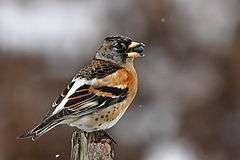Brambling
| Brambling | |
|---|---|
 | |
| Male in Poland | |
| Scientific classification | |
| Kingdom: | Animalia |
| Phylum: | Chordata |
| Class: | Aves |
| Order: | Passeriformes |
| Family: | Fringillidae |
| Subfamily: | Fringillinae |
| Genus: | Fringilla |
| Species: | F. montifringilla |
| Binomial name | |
| Fringilla montifringilla Linnaeus, 1758 | |
The brambling (Fringilla montifringilla) is a small passerine bird in the finch family Fringillidae. It has also been called the cock o' the north and the mountain finch.
Taxonomy
In 1758 Linnaeus included the species in the 10th edition of his Systema Naturae under its current binomial name, Fringilla montifringilla.[2][3] Montifringilla is from Latin mons, montis mountain and fringilla finch.[4] The English name is probably derived from Common West Germanic *brâma, meaning bramble or a thorny bush. (Compare Standard German Brämling with the same meaning.)[5]
Description
The brambling is similar in size and shape to a common chaffinch. Breeding-plumaged male bramblings are very distinctive, with a black head, dark upperparts, orange breast and white belly. Females and younger birds are less distinct, and more similar in appearance to some chaffinches. In all plumages, however, bramblings differs from chaffinches in a number of features:
- brambling has a white rump whereas that of chaffinch is grey-green;
- the breast is orange, contrasting with a white belly on brambling, whereas on chaffinch the underparts of more uniformly coloured (pink or buff);
- brambling's scapular feathers are orange, whereas chaffinch's are grey or grey-brown;
- the flanks are dark-spotted on brambling, plain on chaffinch;
- bramblings lack the white outer tail feathers of chaffinch.
An additional difference for all plumages except breeding-plumaged males is the bill colour - yellow in brambling, dull pinkish in chaffinch (breeding-plumaged male bramblings have black bills, chaffinches in the corresponding plumage have grey bills).[6]
Distribution and habitat
.jpg)
This bird is widespread, in the breeding season, throughout the forests of northern Europe and Asia. It is migratory, wintering in southern Europe, north Africa, north India, northern Pakistan, China, and Japan.[1] It regularly strays into Alaska during migration and may continue as far south as the western United States. The global population of bramblings consists in about 100 - 200 millions birds, with a decreasing trend.[1]
Open coniferous or birch woodland is favoured for breeding.[6]
Behaviour and ecology

This species is almost entirely migratory. In Europe, it forms large flocks in the winter, sometimes with thousands or even millions of birds in a single flock. Such large gatherings occur especially if beech mast is abundant. Bramblings do not require beech mast in the winter, but winter flocks of bramblings will move until they find it. This may be an adaptation to avoid competition with the Chaffinch.[7] Bramblings mostly eat seeds,[6] but unlike most finches, their young are fed largely on insects. It builds its nest in a tree fork,[6] and decorates the exterior with moss or lichen to make it less conspicuous. It lays 4–9 eggs.
References
- 1 2 3 BirdLife International (2012). "Fringilla montifringilla". IUCN Red List of Threatened Species. Version 2013.2. International Union for Conservation of Nature. Retrieved 26 November 2013.
- ↑ Paynter, Raymond A. Jnr., ed. (1968). Check-list of birds of the world, Volume 14. Cambridge, Massachusetts: Museum of Comparative Zoology. p. 206.
- ↑ Linnaeus, C. (1766). Systema Naturæ per regna tria naturae, secundum classes, ordines, genera, species, cum characteribus, differentiis, synonymis, locis, Volume 1 (in Latin) (10th ed.). Holmiae:Laurentii Salvii. p. 179.
- ↑ Jobling, James A (2010). The Helm Dictionary of Scientific Bird Names. London: Christopher Helm. p. 260. ISBN 978-1-4081-2501-4.
- ↑ OED. 2nd edition (1989). Online version (November 2010). Oxford University Press Retrieved 2011-02-21.
- 1 2 3 4 Mullarney, Killian; Svensson, Lars; Zetterstrom, Dan; Grant, Peter (1999). Collins Bird Guide. London: HarperCollins. ISBN 0-00-219728-6.
- ↑ Newton, Ian (1973). Finches. The New Naturalist Library 55. New York: Taplinger. pp. 26–30. ISBN 0-8008-2720-1.
External links
| Wikimedia Commons has media related to Fringilla montifringilla. |
- Internet Bird Collection: Brambling
- Audio recordings from Xeno-canto
- Ageing and sexing by Javier Blasco-Zumeta & Gerd-Michael Heinze
- Stamps Belgium, China, Taiwan
